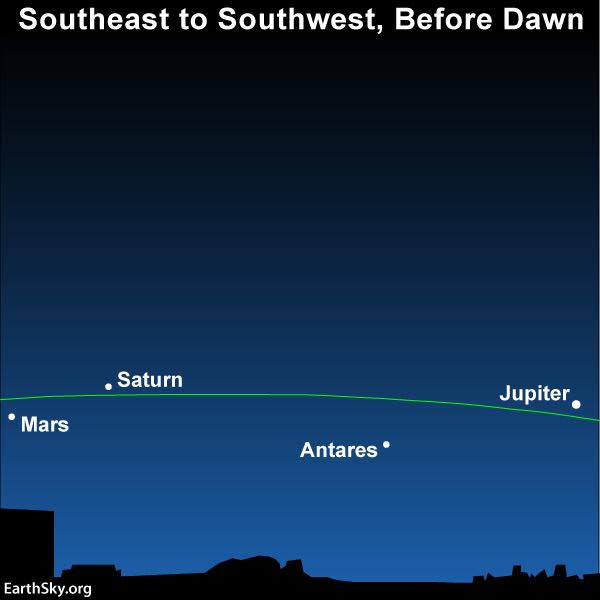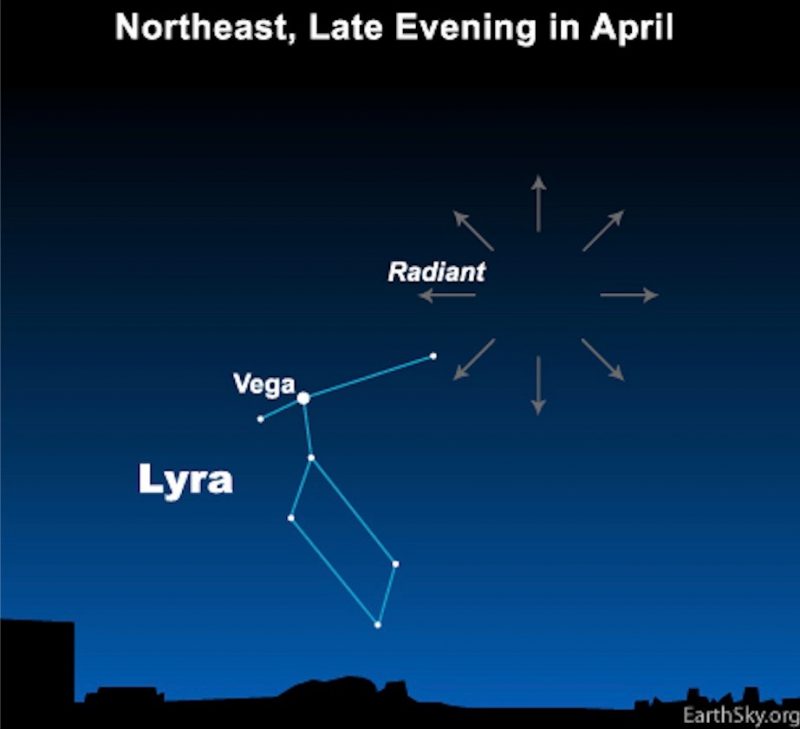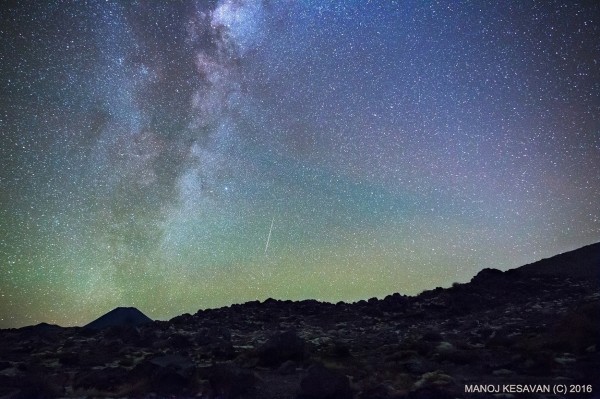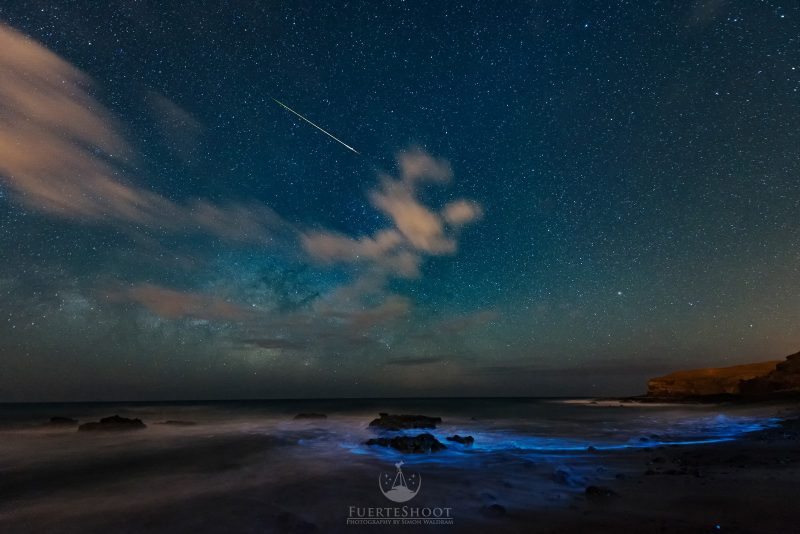
Above: Photo of a Lyrid meteor via EarthSky Facebook friend Guy Livesay
It’s Lyrid meteor time! We expect some Lyrid meteors to fly between late evening on Friday (April 20) until dawn Saturday. And we anticipate Saturday night (April 21) until dawn Sunday to be even better. Sunday morning – April 22, 2018 – is probably the peak, but try again from Sunday night (April 22) until dawn Monday if you’re game. To see the greatest number of meteors, watch in the few hours before dawn on April 21, 22 and 23. That’s when the radiant point – near the star Vega in the constellation Lyra – is highest in the sky, and when you’re likely to see the most meteors.
Note for Southern Hemisphere observers: Because this shower’s radiant point is so far north on the sky’s dome, the star Vega rises only in the hours before dawn. It’ll be lower in the sky for you than for us farther north on Earth’s globe, when dawn breaks. That’s why you’ll see fewer Lyrid meteors. Still, you might see some! Try watching before morning dawn on April 21, 22 and 23.
Good news for all of us this year: The waxing moon will have set by late night, leaving the predawn hours dark for meteor-watching.
More good news: Before dawn, you can see the three planets, Jupiter, Saturn and Mars, plus the star Antares!

Before dawn on these April 2018 mornings, Look for the planet Jupiter to the west of the star Antares, and the planets Saturn and Mars to the east of Antares. We are showing more sky than we usually do in our sky charts, so this planetary line-up will probably look more spread out in the real sky.
The Lyrids aren’t the sky’s richest meteor shower. You might see as many as 10 to 20 meteors per hour in the few hours before Sunday’s dawn. But the Lyrids aren’t an altogether predictable shower. In rare instances, they can bombard the sky with some 60 to 100 meteors per hour.
We’re not expecting a Lyrid meteor outburst this year, but even catching a few meteors before dawn counts as a thrill.
Plus this shower sometimes produces fireballs, or exceptionally bright meteors.

Lyrid meteors radiate from near the bright star Vega in the constellation Lyra the Harp. Read more about the Lyrid’s radiant point.
Why watch for meteors before dawn? Although there are exceptions, most meteor showers are best in the hours after midnight. The key is the shower’s radiant point, in this case in the approximate direction to the bright star Vega. This star rises over the northeast horizon by around mid-evening (9 to 10 p.m. local time) at mid-northern latitudes. South of the equator, this star rises later, in the hours before dawn. The higher that Vega appears in your sky, the more Lyrid meteors you’re likely to see. Since this brilliant beauty of a star soars to its highest point at or near dawn, the best viewing of this shower is usually around then.
Click here to find out when Vega rises into your sky.
Remember, though … you don’t have identify the meteor shower radiant point to enjoy the Lyrid meteors. The meteors radiant from a single point, but they can be seen flying in all parts of the night sky.
Read more about the Lyrid’s radiant point.
Like most meteors in annual showers, Lyrid meteors are the debris of a comet orbiting the sun. They burn up in the atmosphere about 60 miles (100 km) up. Vega, meanwhile, is not really connected with the meteors. It lies trillions of times farther away at 25 light-years.
If you want to watch the shower, be sure to find a place away from artificial lights. Simply recline comfortably while looking in a relaxed way in all parts of the sky.
Want more? Try these links:
Everything you need to know: Lyrid meteor shower
Top ten tips for meteor watchers
EarthSky’s meteor shower guide for 2018

Manoj Kesavan caught this meteor in moonlight during 2016’s Lyrid meteor shower, from Tongariro National Park in New Zealand. He wrote: “I have seen the Milky Way rising over the volcanic complex at various seasons and moon phases. Have shot timelapes and star trails on the volcanic valley which was glacially carved out during the last ice age. This particular one is lit by almost 50% moonlight … this scene never gets old for me!”
Bottom line: The best time to watch Lyrid meteor shower is during the dark hours before dawn, on Sunday, April 22, 2018. Try watching the mornings before and after, too.
EarthSky astronomy kits are perfect for beginners. Order today from the EarthSky store
from EarthSky https://ift.tt/1G2t77H

Above: Photo of a Lyrid meteor via EarthSky Facebook friend Guy Livesay
It’s Lyrid meteor time! We expect some Lyrid meteors to fly between late evening on Friday (April 20) until dawn Saturday. And we anticipate Saturday night (April 21) until dawn Sunday to be even better. Sunday morning – April 22, 2018 – is probably the peak, but try again from Sunday night (April 22) until dawn Monday if you’re game. To see the greatest number of meteors, watch in the few hours before dawn on April 21, 22 and 23. That’s when the radiant point – near the star Vega in the constellation Lyra – is highest in the sky, and when you’re likely to see the most meteors.
Note for Southern Hemisphere observers: Because this shower’s radiant point is so far north on the sky’s dome, the star Vega rises only in the hours before dawn. It’ll be lower in the sky for you than for us farther north on Earth’s globe, when dawn breaks. That’s why you’ll see fewer Lyrid meteors. Still, you might see some! Try watching before morning dawn on April 21, 22 and 23.
Good news for all of us this year: The waxing moon will have set by late night, leaving the predawn hours dark for meteor-watching.
More good news: Before dawn, you can see the three planets, Jupiter, Saturn and Mars, plus the star Antares!

Before dawn on these April 2018 mornings, Look for the planet Jupiter to the west of the star Antares, and the planets Saturn and Mars to the east of Antares. We are showing more sky than we usually do in our sky charts, so this planetary line-up will probably look more spread out in the real sky.
The Lyrids aren’t the sky’s richest meteor shower. You might see as many as 10 to 20 meteors per hour in the few hours before Sunday’s dawn. But the Lyrids aren’t an altogether predictable shower. In rare instances, they can bombard the sky with some 60 to 100 meteors per hour.
We’re not expecting a Lyrid meteor outburst this year, but even catching a few meteors before dawn counts as a thrill.
Plus this shower sometimes produces fireballs, or exceptionally bright meteors.

Lyrid meteors radiate from near the bright star Vega in the constellation Lyra the Harp. Read more about the Lyrid’s radiant point.
Why watch for meteors before dawn? Although there are exceptions, most meteor showers are best in the hours after midnight. The key is the shower’s radiant point, in this case in the approximate direction to the bright star Vega. This star rises over the northeast horizon by around mid-evening (9 to 10 p.m. local time) at mid-northern latitudes. South of the equator, this star rises later, in the hours before dawn. The higher that Vega appears in your sky, the more Lyrid meteors you’re likely to see. Since this brilliant beauty of a star soars to its highest point at or near dawn, the best viewing of this shower is usually around then.
Click here to find out when Vega rises into your sky.
Remember, though … you don’t have identify the meteor shower radiant point to enjoy the Lyrid meteors. The meteors radiant from a single point, but they can be seen flying in all parts of the night sky.
Read more about the Lyrid’s radiant point.
Like most meteors in annual showers, Lyrid meteors are the debris of a comet orbiting the sun. They burn up in the atmosphere about 60 miles (100 km) up. Vega, meanwhile, is not really connected with the meteors. It lies trillions of times farther away at 25 light-years.
If you want to watch the shower, be sure to find a place away from artificial lights. Simply recline comfortably while looking in a relaxed way in all parts of the sky.
Want more? Try these links:
Everything you need to know: Lyrid meteor shower
Top ten tips for meteor watchers
EarthSky’s meteor shower guide for 2018

Manoj Kesavan caught this meteor in moonlight during 2016’s Lyrid meteor shower, from Tongariro National Park in New Zealand. He wrote: “I have seen the Milky Way rising over the volcanic complex at various seasons and moon phases. Have shot timelapes and star trails on the volcanic valley which was glacially carved out during the last ice age. This particular one is lit by almost 50% moonlight … this scene never gets old for me!”
Bottom line: The best time to watch Lyrid meteor shower is during the dark hours before dawn, on Sunday, April 22, 2018. Try watching the mornings before and after, too.
EarthSky astronomy kits are perfect for beginners. Order today from the EarthSky store
from EarthSky https://ift.tt/1G2t77H


Aucun commentaire:
Enregistrer un commentaire